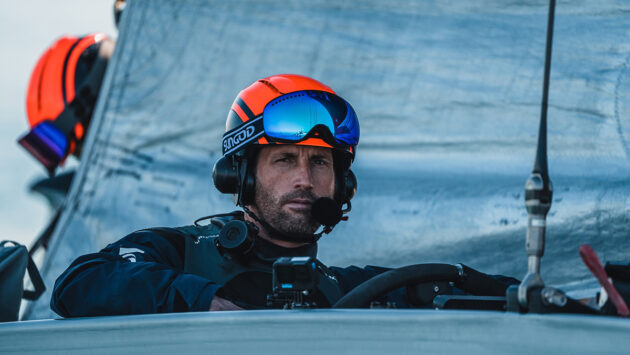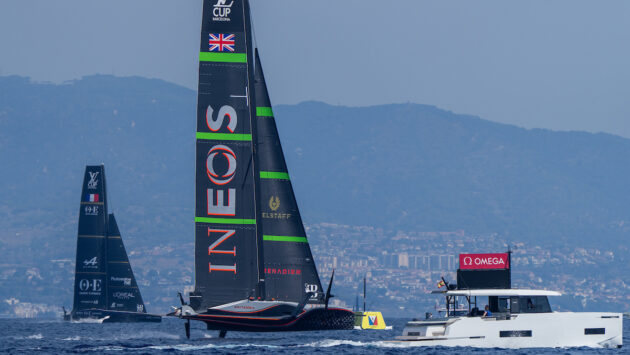Helen Fretter goes behind the scenes with British America’s Cup Challengers INEOS Britannia and gets an exclusive chat with skipper Ben Ainslie
It’s one week to go until the first races of the 37th America’s Cup in the AC75.
Inside the INEOS Britannia base there is a constant clanging: the AC75 Britannia is in for a scheduled four-day refit and upgrade, and the shore team are building a substantial scaffolding structure underneath in order to work on the huge foils. Meanwhile the deck looks like it’s being prepped for surgery, a huge lighting rig suspended above the boat like an operating theatre.
The boat lies in carefully catalogued pieces around the tech zone – fairings off, inner workings uncovered. Unsurprisingly my phone camera lens is covered before I’m allowed in, and there are parts of the service area we are ushered past more quickly than others.
The shore crew are working in a rolling 24-hour schedule, over three shifts. At this point in the game, every second counts.

The INEOS Britannia AC75 at its launch. Photos: Cameron Gregory/INEOS Britannia
Ainslie on Cup competition
But one of the busiest men in Barcelona, INEOS Britannia skipper and team principal, Ben Ainslie, took time out of his schedule to chat to Yachting World. Of all the things he has to keep track of, one week out from the first race for the 37th America’s Cup, what is occupying his thoughts the most?
“Obviously, getting the boat ready. It won’t be totally in its final race spec, but not far from it.
“It’s the same for the other teams as well. You go through all this testing development, you’re constantly trying to improve the boat – and that’ll be the same when we start racing for keeps. But at some point you have to say, ‘Right, now we’ve got to get it into race spec,’ and make sure that everything, from a reliability perspective and finish of the foils in particular, is ready for racing.”
When it comes to making those final decisions, does he still find it a nerve-wracking stage? “There’s always an element of nerves for sure. I think in any sport, when you go into it super confident is normally when you get whacked around the head, isn’t it?
“So, yeah, we’re looking at the competition and the Kiwis and the Italians in particular look really strong, the Americans as well, and Swiss in certain conditions. And I think a lot’s still going to change in the next two, three, four weeks in terms of relative performance of the teams. Then, of course, we’ve got the French with the Kiwi design [Team Orient Express bought an AC75 design package from Emirates Team New Zealand] who could definitely surprise a few people. So it’s going to be a really, really competitive field.”

INEOS Britannia AC75 practising ahead of the 37th America’s Cup in Barcelona
And how is he feeling about the tool he has to race with, the Britannia AC75? “Yeah, good. Good. I think we’re learning a lot about the boat, making some big jumps in performance through different phases of the development since the launch.
“We made some good gains in the last two or three weeks, some really good gains. Hopefully, what we’re doing at the moment is going to get us a few more gains. And if that’s the case, I think we’re going to be in the mix, I think it’s going to be really tight.”
Continuous improvement
But it’s not the boat that looks fastest at the start of the America’s Cup that will necessarily win it.
“We always say, don’t we, the history of the Cup tells us that the teams that develop the most throughout, they’re probably going to be the ones that are most successful – I mean within reason,” says Ainslie.
“I think that’s certainly our approach to it, that we’re going to be pushing hard all the way through to find those gains.
“So we have a sailing support room, both here where the data comes in Barcelona, but also in Brackley [the Mercedes-AMG Petronas F1 Team base which they are partnered]. So when we’re racing or whenever there’s an issue, we’ve got the ability to get resources focused on trying to find out what’s causing that. And then, of course, find a solution to it.
“We’ve seen that’s proven to work really well through the campaign so far, and no doubt it will do through the competition as well. Inevitably, it’s going to be stuff that we realise in certain conditions or manoeuvres that we’re looking for improvements, and how do we find that?

INEOS Britannia skipper Ben Ainslie is juggling helmsman and team principal roles for the 37th America’s Cup
“In terms of the set up here in the base here, that’s in a way very similar to Auckland or Bermuda, the feel just in terms of the shore team and the guys and girls that are really putting the hours in working incredibly hard.
“Of course, back in Auckland, it’s well documented that we had a lot of issues with the boat and the build up to racing, and particularly that Christmas race. We don’t have those issues now, so we’re able to be more focused on properly preparing for the race.”
Dark horse of the America’s Cup
How does he rank the other challengers’ prospects – and how the British squad’s chances are perceived? “I’d be lying if I said I just ignored everything that is observed of the teams, but I don’t really have that much time to trawl through the internet.
“Looking at some of the observations, I think the recon was really interesting because you’d go sailing for a day and then you’d read the recon report and think ‘Is that really the same team?’ so, again, you have to imagine that [perception] was the same for the other teams as well.
“From what I’ve seen, I think the Italians are really strong right now, and the Kiwis as well, of course. I think the Americans have the potential to be. I think we have a huge amount of potential. I’d like to think we’re a bit of a dark horse in all of this. That’s certainly how I see it. But time will tell, won’t it?

The AC75 Britannia’s unveiling in Barcelona
Early clues
“I think certain teams are showing everything. I think some other teams are holding things back, whether that’s on purpose or just because they’ve got some issues which are holding them back.”
Though the AC75s were initially forbidden from lining up alongside one another in any form of two-boat testing or informal racing, ahead of the Preliminary Regatta there have been several event-organised practice races. Primarily designed to allow teams and organisers to test things like on-board media feeds, and the boundary and on-water penalty system, it’s also a first indication for the sailing teams of their relative performance.
“You see a lot, you can take a lot from that. Which teams are strong in certain conditions, certain modes of sailing, what their approach to the starts are. Yeah, it’s a huge amount to note from that. And then that will help you in your pre-race strategy,” Ainslie says.

Practice racing in Barcelona ahead of the Preliminary Regatta.
Final week focus
Right now, how are his stress levels? “Both as an individual and as a team, of course everyone wants to do well. And so there’s a certain anxiety, I think is probably the best way to describe it. I think if you don’t have that, then you probably don’t care. I always think as a sports person, you have a certain amount of it. Otherwise, if you’re just sort of tranquilo, then you probably don’t give a sh*t!
“At the same time, you don’t want people being completely stressed off their heads, running around, making stupid decisions because they’re super nervous. But I’m really pleased with where the team’s at. I think it feels like everyone’s really approaching it well, both from a sailing team perspective, but also the technical team, the shore team. The shore team is working incredibly hard right now, that’s where they’re really putting in the long hours. But everyone’s focussed, knows what we’re trying to achieve and what needs to happen.”
At this stage, is it all about trusting the process? “I think 80% of that’s true, that’s the stuff that you can plan ahead and you know, this is how we want to approach this, this is our timeline.
“But then there’s 20 %, which is things which you can’t control. And then you have to react. That’s part of the game. But that’s fine. As long as the team are capable of reacting to that, then it’s okay.
“And we’ve got a really good team. This is our third campaign. A lot of people have been all the way through. Not all, but a lot of people have been with us through. It’s a lot of experience now in how to take on the challenge of an America’s Cup.”




